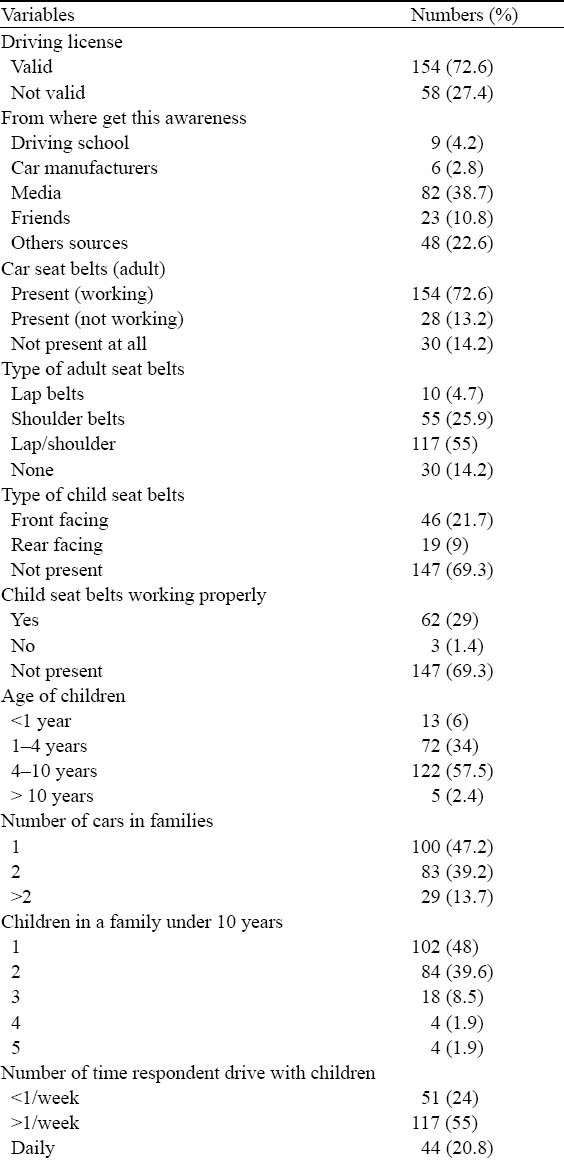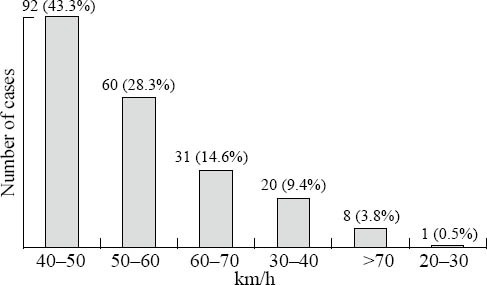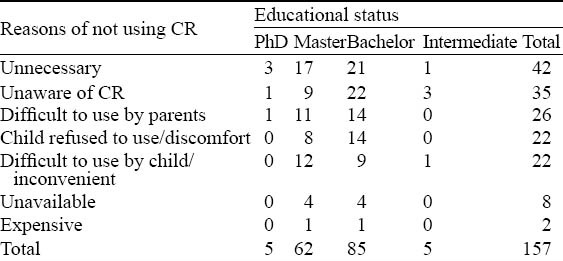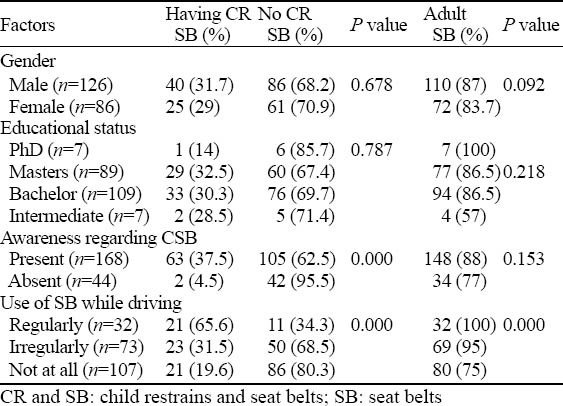Abstract
BACKGROUND:
Motor vehicles crashes (MVCs) are the leading cause of injury related morbidity and mortality in developed countries. Recent evidence proves that properly used child seat belts can dramatically reduce the risk of severe and life-threatening injury from MVCs. There are rarities of thought and inspiration regarding the use of child seat belts in our society and region, therefore we lack of data regarding factors and paucity of usage of child seat belts in motor vehicles. This study aimed to assess the knowledge and attitudes of child seat belt usage among the educated population in Karachi, Pakistan.
METHODS:
Altogether 304 employees were investigated. They were employees of Aga Khan University who were using their cars and having children younger than 10 years old. A cross sectional observational study was designed, and a 36-item questionnaire in English was used to collect data on participants’ demographic details, designation, educational level, economic status, validity of driving license, number of children and cars, availability of adult seat belts and child seat belts along with their functionality, awareness, knowledge and attitude toward its use, and reason of not using these devices. SPSS version 20 for Windows was used to analyze the data and the Chi-square test was used.
RESULTS:
Totally 290 participants were recruited with a response rate of 72% (212). Of 212 participants, 126 (59%) were male. 154 (72.6%) participants had valid driver licenses, and 154 (72.6%) had adult seat belts in their vehicles. Only 32 (15%) reported regular use of adult seat belts. Although 168 (79.2%) participants had some knowledge about child restrains (CRs), only 65 (22%) had CRs in their cars. Eighty-two (38.7%) participants got the knowledge about CRs and seat belts from media. Mothers were more concerned about the use of CRs than fathers. Only 14 (6.6%) parents were found to use both adult and child seat belts all the time. Of the 157 parents who did not us use CRs, 42 considered unnecessary, 35 lacked relevant knowledge. But 15 parents used CR against their children’s wills.
CONCLUSIONS:
The pattern of CR usage among the employees at Aga Khan University, Karachi is dictated by the unavailability of CR, followed by ignorance, inconvenience, and non-acceptance by their children. The important issue of CR has consistently been ignored over the years and it has never gained enough popularity in Pakistan.
KEY WORDS: Child restrains, Motor vehicles crash, Injury prevention, Pakistan
INTRODUCTION
Motor vehicle crashes (MVCs) are the leading cause of pediatric mortality worldwide.[1,2] Child restrains (CRs) are specifically designed to protect children during MVC if used appropriately. Studies have shown that placing the child in an age and size appropriate CR reduces a number of serious and fatal injuries from MVCs.[3,4] According to the National Transport Safety Board in the United States, approximately 1 800 children aged 14 years or less were killed and more than 280 000 were injured in MVCs per year.[5] Appropriate use of CRs reduces the mortality by 71% in the USA during the period of 1993–2000.[6] A similar study on CRs in South Korea showed a decreased mortality rate in children aged less than 15 years from 809 in 1995 to 202 in 2007.[7]
Despite the proven efficacy of CR in reducing mortality among children, its use in the developed countries of Asia is relatively low. For example, the rate of CR use was 16.5% in 1995 and increased to only 22.4% in 2000 in South Korea. In Japan the rate of CR use was 73.7% for infants (0–12 months old) and 47.2% for children (1–4 years old), whereas in the US and other developed countries the rate of CR use was 98% for infants and 93% for children.[8,9]
On the other hand, MVC-related pediatric deaths are increasing rapidly in developing countries in Asia. Pediatric MVC-related deaths are the second most common cause of mortality in children of 5 years old in India.[10] In 2006, there were 10 125 crashes involving 4 193 fatal cases in Pakistan.[11] However, studies on pediatric road trauma and safety from Pakistan and neighboring countries did not comment on the use and potential efficacy of CRs.
With economic and security setbacks in Pakistan, we cannot overlook on the burden the MVC and its related disabilities pose to the nation. The increasing population and number of vehicles along with lack of implementing the road safety measures within the country create dangers to our future generation’s health interest. In Pakistan, children usually travel either in the caregiver’s lap or are seated unbelted and unattended, neither ways provide adequate protection from MVC. There is no specific authority to enforce the implementation of CR usage in Pakistan.
To our knowledge, there are limited reports on the CR use pattern in Pakistan. A majority of parents/caregivers have never used CRs at all. The main objective of the present study was to assess the frequency, knowledge, awareness and attitude toward the use of CRs in the educated population of Aga Khan University Hospital in Pakistan. Moreover, this study also aimed to identify the reasons of not using the CR.
METHODS
Study design
This cross-sectional observational study was conducted at Aga Khan University Hospital, Karachi, one of the largest tertiary care and private teaching hospitals in Pakistan with more than 7 000 employees. The study was approved by the institutional ethical review board. Data of the study were collected from January to June 2009. A study questionnaire was developed after extracting and modifying variables from the literature reviewed.[12] The questionnaire contained 36 items and its validity was tested initially on 25 participants. The co-researcher along with other data collectors distributed the questionnaire to the participants under direct supervision of researchers. All data collectors were trained on data collection techniques.
Data collection
After informed consent was obtained from the participants, data collector and co-researchers conducted a face-to-face interview with the staff working at Aga Khan University Hospital, Stadium Road Campus (AKUH-SRC) Karachi, Pakistan. All employees who owned cars or other four-wheel vehicles and had children younger than 12 years old were included in the study. The employees who did not own four-wheel vehicles, unmarried, or did not have children younger than10 years old were excluded.
Sample size
A convenience sample with sample size of 304 was calculated with a bound on estimation of 5, at 95% confidence interval. Married participants were included in the study because the married or previously married only have children either legal or adopted. Unmarried parents with illegitimate children are culturally unacceptable, hence unmarried parents were excluded from the study. However married couple, divorced, separated or widowed participants may have adopted children. There was no means to estimate the number of participants, we took the help of human resource and security department of the hospital for those who were married and had cars from the university record. Actual driving could not be confirmed by any means. Out of 5 185 full time employees during 2008, we stratified those who were married, divorced, separated or widowed and had the possibility of being parents i.e., 2 033, out of which, 1 433 also had cars and hence chosen as denominator to calculate the sample size. A sample of 304 (21% of 1 433 included cases) cases met the inclusion criteria.
Questionnaire
We developed a 36-item questionnaire which was modified from the CASR-2012 case report from Australia.[12] The language of the questionnaire was English because English is the official language within AKU and is very well understood in the educated population of AKUH.
We collected demographic data of the participants, their designation and educational level, economic status, validity of driving license, number of children and cars in the family, adult seat belt and CR availability and its functional status, along with the frequency of using both adult seat belt and CR, awareness and knowledge including source of obtaining such data, and reason for not using CR. The frequency of driving with children, use of highway and average speed limit were also enquired. Post-accident practice of CR use by parents or care-givers was also analyzed.
Statistical analysis
Outcome variables were calculated by relating three items about awareness and comprising of questions on its use in cars or if they should be used and who informed them of such gadgets. Eighteen items were scored on the usage trends of adult and CR. This was to ensure that the participants appreciated the difference between the two and also compare their own and control information bias and also provide information to compare their own practices which might be affecting their children behavior. The data were recorded in SPSS version 20 by co-authors followed by re-entry and checking for any doubling or errors by the primary author. Statistical analysis was conducted by an expert in the field. Descriptive and analytic analyses were made and the frequencies and percentages were tabulated. The Chi-square test was used to test categorical variables with the dependent variable as the presence of CR in the participant’s car to identify factors influencing CR usage. Alpha was taken as 0.05, with a 95% confidence interval.
RESULTS
We sent questionnaire to a total of 290 participants. The age of 212 respondents ranged from 19 to 48 years. The majority of them were male (126; 59%) (Table 1). The responding participants consisted of 75 (35.3%) physicians, 7 (3.3%) paramedics and 130 (61.3%) management staff members as AKUH-SRC employees.
Table 1.
Demographic data with frequencies

Driving with children
We found that 154 (72.6%) participants reported that they had valid driving license at the time of the study. 100 (47%) participants had one vehicle, 83 (39%) had two vehicles, while 29 (13.7%) had more than two vehicles. 102 (48%) families had one child who was younger than 10 years old, 110 (51.8%) had 2 or more children. 122 (57.5%) participants had children aged 4–10 years, 85 (40%) had children of 4 years old or less. The frequency of driving with children was also noted, 51 (24%) participants drove with children less than once per day or per week, 117 (55%) drove with children more than once per day or per week, whereas 44 (20.8%) drove with children daily. The most common speed they drove with children was 40–50 km/hour. And 173 (81.6%) respondents reported the speed less than 60 km/hour when they drove with children (Figure 1). 143 (67.5%) respondents never drove with their family on highways.
Figure 1.

Usual speed limit while driving.
Use of seat belts
154 (73%) respondents reported to have functional adult seat belts, but in 28 (13%) cars the belts were not functional. In 30 (14%) cars, there were neither adult seat belts nor alteration as they were old model cars. The use of adult seat belts varied from 32 respondents (15%) regularly, 73 (34.4%) irregularly or occasionally, to 107 (50.5%) who never used any belts at all. The frequency of the use of adult seat belts is shown in Table 2.
Table 2.
The reasons of not use of CR and educational status

We found that 168 (79.2%) participants were aware of CRs and most of them were those who already had adult seat belts but refused to use CR (147) (Table 1). Hence, 182 participants had adult seat belts in their cars, and 35 (19%) also had CRs and seat belts. There was no marked difference in gender among participants with regard to the awareness of CR (78.5% and 80% respectively). Electronic media (print and electronic) as the source of information about CR play an important role (82 participants; 38.7%), followed by friends (23; 10.8%) (Table 2). Males (58%) were more likely to get information about CR from media and friends than females (47%).
Of 154 participants with valid driving license, 53 (34%) had CRs in their cars and 12 who were devoid of valid driving license had CRs. Seven participants with a doctorate degree had adult seat belts but only one (14%) had CRs and seat belts in their cars. Seventy-seven (86.5%) participants with a master degree had adult seat belts and 29 (32.5%) had CRs and seat belts in their cars. We also found that 94 (90.3%) participants with a bachelor degree had adult seat belts in contrast to 31 (28.4) bachelors who had CRs and seat belts. The level of awareness for CRs among the educated population ranged from 71% to 85%. In 212 participants, 65 had CRs in their cars, 62 (29%) had CRs and seat belts which were potentially functional; whereas 147 (69.3%) participants did not have CRs and seat belts. Of the 65 participants, 46 had child seat belts which were front facing and 19 were rear facing (Table 2).
Comparison of the use of adult and child seat belts in the respondents showed that only 14 (6.6%) parents used both adult and child seat belts whenever they drove their cars. Ninety (42.4%) respondents never used both belts. Commonly, 115 (54%) fathers drove cars for their families, followed by 50 (23.6%) mothers. Mothers were more responsible than fathers or other drivers in CR usage while driving with children (P=0.000). In 59 (27.8%) drivers who experienced accidents, 30 were mothers; however, 46 of 48 mothers were belted. Fathers as drivers experienced 8 accidents, and at 7 occasions they were not belted (P=0.000). Forty-five children were belted at accidents, whereas children were not belted at 14 accidents (P=0.000).
Reasons of either not using CR or using occasionally were disclosed by 157 (74%) participants. Fifteen parents used CRs and seat belts by force against the will of their children and 7 left their children unbelted at times. Interestingly, most nonusers (89) were found in 4 to 10-year-old children, followed by 1 to 4-year-old children (55). In the 4 to 10-year-old children, 24 (57%) parents considered CR unnecessary (Table 3).
Table 3.
Demography and factors influencing CR BS use in the participants

DISCUSSION
The results of this study demonstrated the hindrance of using CRs was stemmed from ignorance rather than lack of awareness. A large number of respondents considered CR unnecessary, difficult or inconvenient to use, and expensive, which reflected the ignorance of parents of children to CR use.
Winston et al[9] identified that elderly parents and those who were illiterate or had low degree of education and low socioeconomic status were independent factors for unpopularity of CRs. The population in this study was relatively educated, mostly middle aged, yet most of them were not using CR despite they were aware of the importance of CR. Inconvenience, casual attitude and non-acceptance by their children also play a vital role in addition to the lack of knowledge, unavailability and high cost of CR, as compared to the observation by William FA.[10] Similarly, the Motor Vehicle Occupant Safety Survey (MVOSS) also found these reasons.[11,12] Driving for shorter distance was another reason for not using CR, followed by “just forgot” or the child being cared by adults.
Most parents were young or middle aged with children less than 10 years old.[13,14] Children enjoy driving with parents on weekends usually for shorter distances, thus the habit of using CR was not adequately practiced as it should be.[14] Parents felt useless to buckle up themselves and their children with CR if drove slow and for short distances, rather the misconception of short distance and slower speed limits does not protect children from crash injury.[14] This might be an example of lack of awareness rather ignorance. This was further proofed by Lennon[13] who observed that economically well-off families or fewer children did not influence the use of CR. In contrast, more cars within a family decreased the frequency of CR usage as most had only one CR and was adjusted or planted in one car. Driving with other car along with children for any reason and transferring of CR from one car to another even if available was glitch feelings by parents.
Unavailability of CR is another issue our parents faced, however this has been accepted by few parents and we also did not elaborate the efforts taken by parents for its availability. CR is available in only a few stores in the city with limited selection for age or weight appropriate model. Furthermore, the price of CR, ranging from 100 to 250 $ US (10 000 to 25 000 Pak Rupees), is relatively high for the majority of parents. The other obstacle in using CR is lack of technical support or knowledge on implementation of CR in the vehicle. Most car manufactuers in Pakistan did not have rear adult seat belts or any buckling sockets or points for CR implementation until the last decade. Lack of traffic safety legislation and inefficient enforcement of the existing laws along with inadequate training which mostly is provided by non-supervised, unregulated training institutes within the cosmopolitan vicinity limit the opportunity to promote the parents’ awareness of road safety procedure including proper CR usage.
Despite our study population was well-educated, a significant number of parents/drivers did not have valid driving license. It was more difficult and expensive to get driver license than to pay penalty. Front seat adults were belted at times, but children and rear seat passengers were almost always not restrained. Resistance from children toward CR and their behavioral patterns were dictated by the adults’ attitude and perseverance. Parents responded to this by reaffirming their rules, though some parents reported a constant struggle to maintain their authority while others let it go.[13] Results showed that if the adults wore seat belts, their children were likely to accept wearing CR as well. On the contrary, our parents themselves were casual in wearing seat belts, but vigilant and cautious in restraining their children while driving especially when children were seated in the front. However parents were more casual in belting children when they were seated in the rear seats. According to the recommendations by the NHTSA, infants up to one year of age or under 20 pounds should be in a rear-facing child car seat and children between 1–3 year-old should be in a rear-facing car seat as long as possible or until the child reaches the maximum height or weight allowed by car seat manufacturer.[15]
Limitations
The results of the present study may not be generalized to reflect the overall population of Pakistan. However, we assumed that the educated AKUH population should be well aware of adult seat belts and CRs, given the high educational level and regular awareness campaign regarding safe driving providing in the hospital.
The nature of survey study could lead to recall bias and social bias when a person is likely to give answer that he or she thinks is socially appropriate, for example in question regarding speed limit. Our study also did not perform comparisons between the CR usage on highways and inter-city road, time of days or weeks, the types of car, and the attitude of driver toward wearing seat belts. Proper technique and age adjusted CR usage was also not taken into account. Different socioeconomic strata should also be explored for possible difference in reasons behind not using CR.
Footnotes
Funding: None.
Ethical approval: The ethical committee of hospital approved this study.
Conflicts of interest: The authors of the study do not have any conflicts of interest.
Contributors: Siddiqui E proposed the study, analyzed the data and wrote the first draft. All authors contributed to the design and interpretation of the study and to further drafts.
REFERENCES
- 1.United Nations Children's Fund. A league table of child deaths by injury in rich nations. 2001. [Accessed January 2, 2009]. Available at: http://www.unicefirc.org/publications/pdf/repcard2e.pdf .
- 2.London: Department for Transport; [Accessed October 14, 2009]. Children's road traffic safety: an international survey of policy and practice. Available at: http://www.dft.gov.uk/pgr/roadsafety/research/rsrr/theme1/childrensroadsafetyaninterna.pdf . [Google Scholar]
- 3.Arbogast KB, Durbin DR, Morris SD, Winston FK. Assessing child restraint misuse by parental survey. Inj Prev. 2000;6:145–147. doi: 10.1136/ip.6.2.145. [DOI] [PMC free article] [PubMed] [Google Scholar]
- 4.Berg MD, Cook L, Corneli HM, Vernon DD, Dean JM. Effect of seating position and restraint use on injuries to children in motor vehicle crashes. Pediatrics. 2000;105:831–835. doi: 10.1542/peds.105.4.831. [DOI] [PubMed] [Google Scholar]
- 5.National Transportation Safety Board's New Recommendations for Child Safety Seats. [download on December 23, 2010]. http://michigancaraccidentattorneys.blogsml.com/national transportation-safety-boards-new-recommendations-for-child-safety-seats.html .
- 6.National Highway Traffic Safety Administration: Traffic Safety Facts. Children. 2001. [Accessed February 20, 2003]. Available at: http://www-nrd.nhtsa.dot.gov/pdf/nrd-30/NCSA/TSF2001/2001children.pdf .
- 7.Road Traffic Authority. Road traffic accidents in Korea. 2007. [Accessed October 24, 2009]. Available at: http://www.rota.or.kr/Work/Code/RotaSafety/download/e2007.pdf .
- 8.Yoon HS, Kim YD. Parental Awareness and perception for correct use of child occupant restraints in Korea. Traffic Injury Prevention. 2010;11:279–285. doi: 10.1080/15389581003664875. [DOI] [PubMed] [Google Scholar]
- 9.Mohan D, Anderson R. TRIPP. New Dehli: 2000. Injury prevention and control: international course on injury prevention and control. [Google Scholar]
- 10.Aizaz Ahmed. National Road Safety Secretariat Ministry of Communications Government of Pakistan. Road safety in Pakistan. June 21st, 2007. [download on December 23, 2010]. http://www.unescap.org/ttdw/common/Meetings/TIS/EGM%20Roadsafety%20Counry%20Papers/Pakistan_Roadsafety.pdf .
- 11.Seat Belt Report March. Chapter 2. Vol. 2. NHTSA; 2000. [download on December 23, 2010]. Reasons for seat belt use and non-use. Motor Vehicle Occupant Safety Survey. http://www.nhtsa.gov/people/injury/research/SafetySurvey/index.html . [Google Scholar]
- 12.Edwards SA, Anderson RGW, Hutchinson TP. A survey of drivers’ child restraint choice and knowledge in South Australia. Case Report, CASR012 May 2006 ISBN #192094711 6 ISSN # 1449–2237. [Downloaded on January 10, 2012]. http://casr.adelaide.edu.au/reports .
- 13.Lennon AJ. Brisbane: Queensland Transport (CD-ROM), Gold Coast, Queensland; 2006. Oct, [downloads on 29/12/2010]. Parental perceptions of legitimate reasons to relax their seating rules for children in cars. (2006). Proceedings the Australasian Road Safety Research, Policing and Education Conference, Gold Coast, Queensland, 25–26. http://eprints.qut.edu.au . [Google Scholar]
- 14.Chen IG, Durbin DR, Elliott MR, Kallan MJ, Winston FK. Trip characteristics of vehicle crashes involving child passengers. Inj Prev. 2005;11:219–224. doi: 10.1136/ip.2004.006767. [DOI] [PMC free article] [PubMed] [Google Scholar]
- 15.National Highway Traffic Safety Administration. Federal Motor Vehicle Safety Standards; Child Restraint Systems. 2004. [cited May 2010]. Available from: http://www.nhtsa.gov/DOT/NHTSA/Rulemaking/Rules/Associated%20Files/SchoolBusBeltsFinal.pdf .


